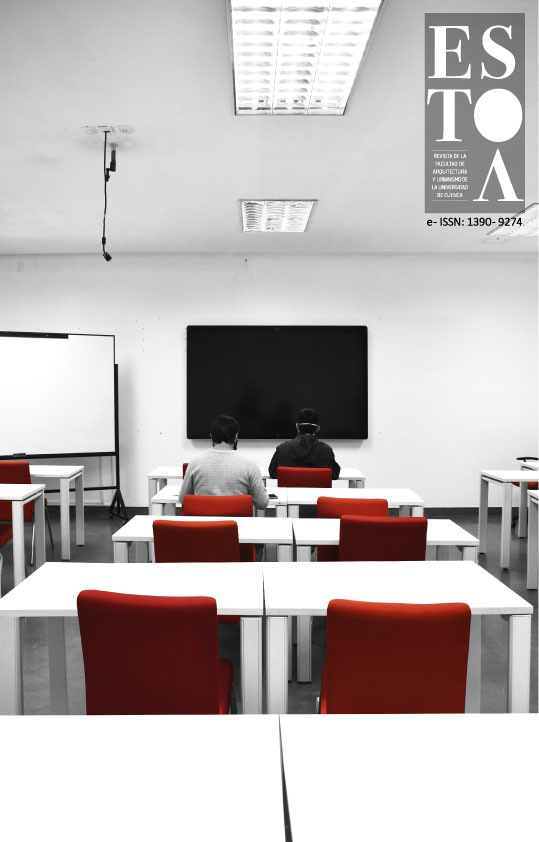Classification of the deterioration of stone façades in Cuban colonial buildings
DOI:
https://doi.org/10.18537/est.v009.n018.a04Keywords:
stone facades, deterioration, terminology, environment, built heritageAbstract
The historic stone buildings in Cuba are under environmental factors that affect their integrity and cultural heritage values. In spite of the practices of conservation and restoration, may appear new signs of alteration and/or similar to the previous ones that existed before the refurbishment. The objective of the present work involved a proposal of classification of the alteration and deterioration of stone in façades and walls of buildings with given cultural values, taking into account the worldwide terminology widely used. It assumed researchers’ positions of recognized authority in the topic, setting up the authors’ points of view, adapted to the specific conditions of the site, Old Havana, declared World Heritage by UNESCO. It was used the integrated multi-modal fact-finding method, a combination of qualitative and quantitative focuses, that allowed elucidating the relation with the factors of deterioration in different environmental scales and as result, an adaptable terminology to the Cuban context.
Downloads
References
Alfonso, A. (2020). La imagen cromática de La Habana. Arquitectura y Urbanismo, 41(1), 35-46.
Añorbe, M. (1997). Valoración del deterioro y conservación en la piedra monumental. Madrid, España: Ministerio de Fomento; CEDEX.
Arencibia S. (2018). Caracterización y valoración del deterioro de la piedra en construcciones de valor cultural del Centro Histórico La Habana Vieja. (tesis doctoral). Universidad Tecnológica de La Habana, La Habana, Cuba.
Arencibia S., Romeo, A. y Fernández, N. (2015). Formas de deterioro presentes en las fachadas de piedra de El Arsenal. Arquitectura y Urbanismo, 36(3), 79-91.
Barbosa, A. L., Guzmán-Bohórquez, A., Calderón, Y. y Tatis R. D. (2020). Deterioro y restauración del baluarte de Santiago murallas de Cartagena entre 2007-2019: un estudio fisicoquímico. Respuestas, 25(1) 6-18. Recuperado de Recuperado a partir de https://revistas.ufps.edu.co/index.php/respuestas/article/view/1895
Becerra, J., Ortiz, P., Martín, J. M. y Zaderenko A. P. (2019). Nanolimes doped with quantum dots for stone consolidation assessment. Construction and Building Materials, (199), 581–593.
Consiglio Nazionale delle Ricerche e Dell'istituto Centrale per il Restauro [CNR-ICR]. (1990). Alterazioni macroscopiche dei materiali lapidei: lessico. Roma, Italia: NORMAL-1/88.
Esbert, R. M., Alonso F. J. y Ordaz, J. (2008). La petrofísica en la interpretación del deterioro y la conservación de la piedra de edificación. Trabajos de Geología, (28), 87-95.
Fitzner, B., Heinrichs y La Bouchardiere, D. (2003). Weathering damage on Pharaonic sandstone monuments in Luxor-Egypt. Building and Environment, 38(9-10), 1089–1103. doi:10.1016/S0360-1323(03)00086 6
Hernández, R., Fernández, C. y Baptista, P. (2006). Metodología de la Investigación. México DF, México: Interamericana Editores.
Jokilehto, J. (2006). Considerations on authenticity and integrity in World Heritage context. City & Time, 2(1), 1-16.
Molina, J. C. (2011) Intervención en el estrato de pátinas originales en el primer cuerpo de la torre de la Catedral de Murcia. XXII Jornadas de Patrimonio Cultural de Murcia (pp. 441-449). Cartagena, España: Universidad Politécnica de Cartagena.
Oficina Nacional de Normalización. (2000). Norma cubana NC 56:2000. Especificaciones de bloques de rocas (3ª ed.). La Habana, Cuba.
Ordaz, J. y Esbert R. M. (1988). Glosario de términos relacionados con el deterioro de las piedras de construcción. Materiales De Construcción, 38(209), 39-45.
Orenday E., Tapia E. y Pacheco J. (2019). Intervenciones no destructivas para el diagnóstico de la salud estructural de dos templos de Aguascalientes, en México. Intervención, (19), 85-98. doi: 10.30763/Intervencion.2019.19.211
Pérez, L. (2000). Estudio de los deterioros de la Fortaleza San Carlos de la Cabaña. Ingeniería Civil, 119(8), 133-142.
Reunión Internacional de Laboratorios de Ensayos de Materiales [RILEM], (1980). Essais recommandés pour mesurer l’altératión des pierres et évaluer l’efficacité des methods de traitement. Commission 25-PEM Protection et Érosion des Monuments. Materiaux et Constructions, 13(75), 175-243.
Rocha D., Becerra J., Benavente D., Cañaveras J. y Costa A. (2019). Estudio preliminar de las características petrográficas, petrofísicas y comportamiento mecánico de rocas naturales tipo “Piedra Bogotana” y “Mármol Royal Bronce” utilizadas en construcciones patrimoniales y recientes en Colombia. UIS Ingenierías, 18(3), 203-222. doi: 10.18273/revuin.v18n3-2019021
Rodríguez, P., Fornet, P., Águila A., Cruz, N., Fernández, C., Pérez, M., Padrón, M., Álvarez, N., Pedroso, A., Sánchez, K., Viciedo, D., Casanovas, E., Laborí, C. y Nuez, F. (2016). Plan especial de desarrollo integral 2030. Habana Vieja (pp. 30-72). La Habana, Cuba: Ediciones Boloña.
UNESCO. (2012). Reporte del Encuentro Internacional de Expertos sobre Integridad del Patrimonio Cultural. Al Ain, Emiratos Árabes Unidos: UNESCO.
Vázquez, C., Álvarez de Buergo, M. y Fort, R. (2014). Estudio de pátinas de oxalatos y fosfatos cálcicos en monumentos de Cifuentes. Geogaceta (15), 43-46.
Verges-Belmin, V. (2011). Glosario ilustrado de formas de deterioro de la piedra. Versión Inglés - español. (1ª ed. 2008). París, Francia: ICOMOS.
Published
How to Cite
Issue
Section
License
The Journal declines any responsibility for possible conflicts derived from the authorship of the works that are published in it.
The University of Cuenca in Ecuador conserves the patrimonial rights (copyright) of the published works and will favor the reuse of the same ones, these can be: copy, use, diffuse, transmit and expose publicly.
Unless otherwise indicated, all contents of the electronic edition are distributed under a Creative Commons Attribution-NonCommercial-ShareAlike 4.0 International License.




